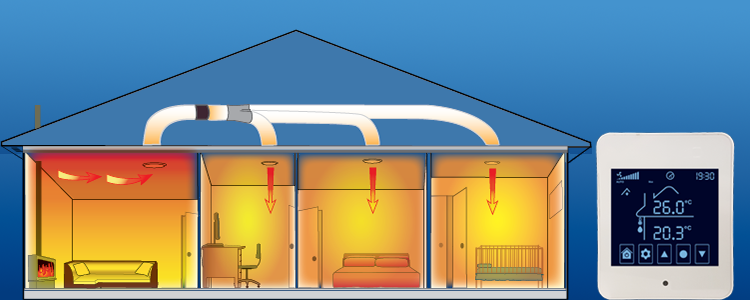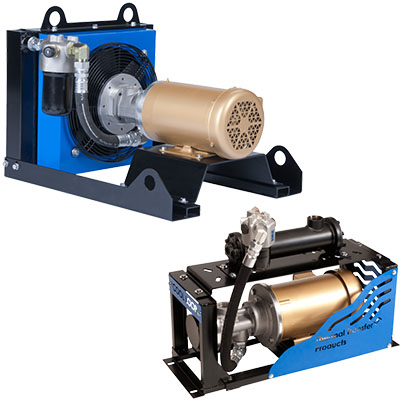A Comprehensive Guide to Choosing the Right Heat Transfer Systems for Your Requirements
Selecting the proper Heat transfer system is crucial for functional performance. Different systems cater to different demands, affected by elements such as temperature level variety and fluid type. Recognizing the principles behind Heat transfer, such as transmission, convection, and radiation, is vital. Furthermore, reviewing power resources and maintenance practices can affect long-term performance. A closer assessment of these factors to consider reveals just how to tailor a system to certain needs. What should one prioritize in this facility decision-making process?
Understanding Heat Transfer: Key Concepts and Concepts
Although Heat transfer might feel like a simple idea, it incorporates a series of principles that are basic for reliable system layout. Understanding these principles is crucial for designers and developers that intend to optimize thermal performance in numerous applications. Transmission, as an example, includes the transfer of Heat through strong materials, while convection refers to the motion of Heat within liquids. Radiation, one more essential principle, explains how Heat can be transferred via electro-magnetic waves. Each of these devices plays a vital duty in establishing how power relocates within a system. By extensively comprehending these concepts, professionals can make educated choices, making sure that Heat transfer systems operate efficiently and meet the specific needs of their applications
Sorts Of Heat Transfer Systems: An Overview
Understanding the concepts of Heat transfer prepares for discovering the various kinds of Heat transfer systems available. Heat transfer systems can be classified mostly into 3 types: transmission, convection, and radiation. Transmission involves Heat transfer through strong products, depending on straight call between fragments. Convection, on the other hand, occurs in liquids (gases and liquids) where the movement of the fluid itself promotes Heat transfer. Radiation involves the transfer of Heat with electromagnetic waves and does not call for a medium, enabling it to happen in a vacuum cleaner. Each kind of system has distinctive characteristics and applications, making it crucial for individuals and organizations to carefully evaluate their details needs when choosing one of the most ideal Heat transfer remedy.
Applications of Heat Transfer Solutions in Various Industries
Heat transfer systems play an important role throughout different industries, affecting effectiveness and product top quality. In industrial manufacturing procedures, they assist in exact temperature level control, while in food and drink processing, they assure safety and conservation. In addition, heating and cooling and climate control systems rely heavily on effective Heat transfer to keep comfy settings.
Industrial Manufacturing Processes

Numerous commercial production processes rely greatly on effective Heat transfer systems to maximize efficiency and boost item top quality. In sectors such as metalworking, Heat exchangers play an essential role in preserving ideal temperatures throughout welding, casting, and building. These systems assure consistent Heat distribution, which is vital for attaining wanted material homes. In the chemical manufacturing market, Heat transfer systems assist in exact temperature level control throughout reactions, affecting yield and safety. In textile production, reliable Heat management is crucial for dyeing and finishing procedures, influencing color uniformity and textile top quality. By picking ideal Heat transfer modern technologies, makers can boost power efficiency and reduce functional expenses, ultimately causing a more competitive and lasting production environment.
Food and Beverage Handling
Reliable Heat transfer systems are similarly essential in the food and drink handling sector, where keeping optimal temperatures is essential for food security and high quality. These systems play an essential role in procedures such as pasteurization, cooking, and sanitation, making sure that products are risk-free for usage and preserve their dietary worth. Heat exchangers, for circumstances, successfully transfer Heat in between fluids, enhancing energy use while reducing temperature changes. In addition, refrigeration systems are basic for prolonging and protecting subject to spoiling products life span. The selection of Heat transfer modern technology directly impacts functional performance and item stability, making it imperative for food and beverage makers to select the appropriate systems customized to their specific processing demands. This cautious option inevitably adds to customer complete satisfaction and food safety and security.

Cooling And Heating and Environment Control
While several markets count on Heat transfer systems for effectiveness, HEATING AND COOLING (Heating, Ventilation, and A/c) plays a vital function in preserving visit homepage indoor environment control throughout various settings. These systems utilize Heat transfer principles to manage temperature, moisture, and air top quality, ensuring comfort and safety and security in residential, commercial, and industrial atmospheres. Properly created a/c systems enhance energy performance, reduce functional costs, and reduce environmental effect. In commercial structures, for instance, reliable climate control contributes to worker performance and client satisfaction. In industrial applications, cooling and heating systems help keep perfect problems for equipment operation and product conservation. Choosing the ideal Heat transfer system is crucial for conference specific environment control requirements and attaining general system efficiency.
Reviewing Power Resources for Heat Transfer Systems
In examining power resources for Heat transfer systems, a contrast of sustainable energy alternatives and nonrenewable fuel source considerations is necessary. Eco-friendly sources, such as solar and wind, offer sustainable choices that can minimize environmental influence. On the other hand, fossil fuels remain prevalent because of their established framework and power density, triggering a mindful evaluation of both options.
Renewable Energy Options

Nonrenewable Fuel Source Factors To Consider
Reviewing nonrenewable fuel source factors to consider is important for the effectiveness and sustainability of Heat transfer systems. Fossil gas, such as gas, oil, and coal, are conventional energy sources that give significant Heat outcome, making them popular choices for household and industrial applications. However, their environmental effect, consisting of greenhouse gas exhausts and source exhaustion, elevates problems. When choosing a warmth transfer system, it is crucial to evaluate the availability, price, and governing aspects connected with these gas. In addition, the effectiveness of nonrenewable fuel source systems have to be thought about, as higher effectiveness can minimize some ecological drawbacks. Ultimately, a well balanced method weighing efficiency and sustainability can direct decision-makers toward one of the most appropriate Heat transfer solution for their details demands.
Elements to Consider When Choosing a Warm Transfer System
Selecting an ideal Heat transfer system requires mindful consideration of numerous elements that can substantially affect effectiveness and efficiency. One crucial element is the operating temperature range, which determines the products and layout ideal for the application. In addition, the kind of liquid made use of in the system-- whether gas or liquid-- affects Heat transfer performance and compatibility. The system's size and capability have to straighten with the specific demands of the operation to stay clear of inefficiencies. Energy resource availability is also important, affecting operating expenses and sustainability. In addition, the installment environment, including space restraints and accessibility for upkeep, plays a substantial duty in system option. Regulative conformity and safety and security criteria need to be taken into consideration to ensure the system satisfies all legal requirements.
Upkeep and Efficiency Optimization for Heat Transfer Solutions
Keeping Heat transfer systems is essential for making certain optimal performance and durability. Routine maintenance activities, such as cleansing Heat exchangers and examining insulation, aid avoid efficiency losses as a result of fouling and thermal linking. Additionally, checking right here system specifications, consisting of pressure and temperature, enables for early discovery of anomalies, decreasing downtime and costly fixings. Implementing a precautionary maintenance routine can optimize efficiency and extend the lifespan of elements. In addition, upgrading to sophisticated control systems can boost operational effectiveness by changing to varying conditions and tons. By focusing on upkeep and effectiveness optimization, operators can achieve minimized power consumption, lower operational costs, and boosted total system integrity, eventually causing much better resource utilization and an extra lasting operation.
Future Fads in Heat Transfer Technologies
As markets increasingly prioritize sustainability and power performance, future fads in Heat transfer innovations are readied to undergo significant changes. Developments such as innovative materials, consisting of carbon nanotubes and nanofluids, promise boosted thermal conductivity and effectiveness. In addition, the assimilation of renewable resource sources into Heat transfer systems is acquiring momentum, promoting environment-friendly services. Smart innovations, including IoT sensing units, are anticipated to change monitoring and control, allowing real-time data evaluation for maximized performance. In addition, the growth of small and modular systems will assist in simpler Visit Your URL installment and upkeep, dealing with varied applications. These developments indicate a shift towards more sustainable, effective, and versatile Heat transfer remedies, straightening with international power objectives and environmental requirements.
Regularly Asked Concerns
What Are the Environmental Effects of Heat Transfer Equipments?
The environmental influences of Heat transfer systems can consist of greenhouse gas discharges, energy consumption, and prospective thermal air pollution. Furthermore, improper disposal of inadequacies and products can add to resource deficiency and community disruption.
Exactly how Do I Compute the Cost-Effectiveness of a Warm Transfer System?
To determine the cost-effectiveness of a warm transfer system, one should assess initial expenses, functional costs, upkeep needs, and energy efficiency, comparing these factors versus the expected life expectancy and efficiency of the system.
Can Heat Transfer Solution Be Utilized in Residential Settings?
Heat transfer systems can indeed be used in property setups. They supply reliable home heating and cooling options, making homes a lot more comfortable while possibly lowering energy prices. Their flexibility enables various applications in property atmospheres.
What Safety And Security Laws Relate To Heat Transfer Systems?
Safety and security policies for Heat transfer systems normally include guidelines on installation, maintenance, and operation. Conformity with neighborhood building codes, manufacturer specifications, and sector requirements is necessary to assure risk-free and reliable system performance in different applications.
How Do Various Materials Affect Heat Transfer Effectiveness?

Transmission, for instance, includes the transfer of Heat with strong materials, while convection refers to the motion of Heat within liquids. Recognizing the concepts of Heat transfer lays the foundation for discovering the numerous types of Heat transfer systems available. Heat exchangers, for circumstances, efficiently transfer Heat in between liquids, maximizing power usage while decreasing temperature fluctuations. In evaluating energy resources for Heat transfer systems, a contrast of renewable power choices and fossil gas considerations is essential. Metals, such as copper and light weight aluminum, conduct Heat successfully, whereas insulators like rubber and glass slow down Heat circulation.